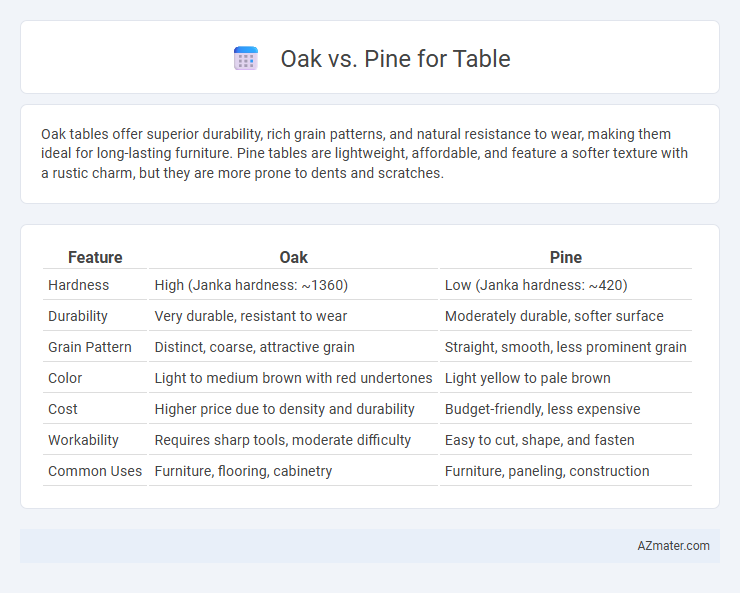Oak tables offer superior durability, rich grain patterns, and natural resistance to wear, making them ideal for long-lasting furniture. Pine tables are lightweight, affordable, and feature a softer texture with a rustic charm, but they are more prone to dents and scratches.
Table of Comparison
| Feature | Oak | Pine |
|---|---|---|
| Hardness | High (Janka hardness: ~1360) | Low (Janka hardness: ~420) |
| Durability | Very durable, resistant to wear | Moderately durable, softer surface |
| Grain Pattern | Distinct, coarse, attractive grain | Straight, smooth, less prominent grain |
| Color | Light to medium brown with red undertones | Light yellow to pale brown |
| Cost | Higher price due to density and durability | Budget-friendly, less expensive |
| Workability | Requires sharp tools, moderate difficulty | Easy to cut, shape, and fasten |
| Common Uses | Furniture, flooring, cabinetry | Furniture, paneling, construction |
Introduction to Oak and Pine Tables
Oak tables feature dense hardwood renowned for durability and rich grain patterns, providing a sturdy and long-lasting furniture piece ideal for high-use environments. Pine tables, made from softwood, offer a lighter, more affordable option with natural knots and a warm, rustic appearance that suits casual or country-style interiors. Both woods allow for customizable finishes, but oak's hardness resists dents and scratches better than pine, making it preferable for heavy or frequent use.
Key Differences Between Oak and Pine
Oak offers superior durability and hardness compared to pine, making it ideal for heavy-use tables that require long-lasting strength. Pine is a softer wood with a lighter color and more visible knots, providing a rustic aesthetic but less resistance to dents and scratches. Oak features a tighter grain pattern and richer color variations, enhancing the table's visual appeal and making it more suitable for formal or traditional settings.
Durability and Strength Comparison
Oak offers superior durability and strength compared to pine, making it a better choice for heavy-use tables. Its dense grain structure provides enhanced resistance to dents, scratches, and everyday wear. Pine, while lighter and softer, is more prone to surface damage and may require more maintenance over time.
Appearance and Grain Characteristics
Oak tables showcase a pronounced, open grain pattern with visible rays and flecks, offering a rich, textured appearance that ages beautifully with a warm, amber hue. Pine tables present a softer, more uniform grain with occasional knots, lending a rustic and casual charm with lighter, creamy tones. The contrast between oak's intricate, coarse grain and pine's smoother, more subtle patterns influences the table's aesthetic and suitability for various interior styles.
Color and Finish Options
Oak offers a rich variety of warm hues ranging from light amber to deep reddish-brown, with a pronounced grain that enhances classic and rustic table designs. Pine features a lighter, more uniform color palette, typically creamy yellow to pale beige, which can be easily stained or painted for versatile finish options. Both woods accept finishes well; oak's dense grain provides a smooth, durable surface ideal for varnishes and oils, while pine's softer texture absorbs stains unevenly but allows for creative distressed or whitewashed effects.
Cost and Affordability
Oak tables tend to be more expensive than pine due to oak's density and durability, which contribute to higher material and manufacturing costs. Pine offers an affordable alternative with lower initial cost, making it ideal for budget-conscious buyers seeking a lightweight and easily workable wood. While oak's price reflects long-term investment in strength and elegance, pine provides cost-effective options without compromising on basic functionality.
Maintenance and Care Requirements
Oak tables demand regular cleaning with a damp cloth and periodic application of wood polish to maintain their durability and rich grain texture. Pine tables require more frequent sealing or waxing to protect their softer wood surface from dents, scratches, and moisture damage. Both woods benefit from avoiding harsh chemicals and excessive moisture to prolong their lifespan and preserve appearance.
Sustainability and Environmental Impact
Oak tables offer durability and long lifespan, reducing the need for frequent replacement and minimizing resource consumption, benefitting sustainability. Pine grows faster than oak, providing a more renewable source of wood with a lower carbon footprint due to shorter growth cycles and less intensive harvesting. Choosing responsibly sourced oak or pine certified by organizations like FSC ensures reduced environmental impact and supports sustainable forestry practices.
Best Uses for Oak and Pine Tables
Oak tables provide exceptional durability and a rich grain texture, making them ideal for heavy-use areas like dining rooms and offices where longevity is crucial. Pine tables offer a lightweight, affordable option with a softer wood that suits casual or rustic settings, perfect for kitchens, craft rooms, or children's play areas. Both woods can be finished to enhance their natural beauty, but oak excels in formal spaces while pine thrives in relaxed, informal environments.
Which Is Better for Your Table: Oak or Pine?
Oak is generally better for tables due to its durability and resistance to dents and scratches, making it ideal for heavy use and longevity. Pine, while softer and more affordable, tends to show wear and dents more quickly but offers a rustic charm with its light color and grain patterns. For a long-lasting, sturdy table, oak is the preferred choice, whereas pine suits budget-friendly, decorative pieces.

Infographic: Oak vs Pine for Table
 azmater.com
azmater.com